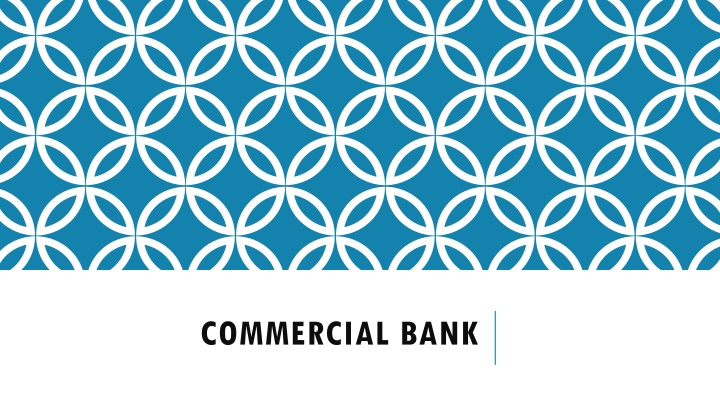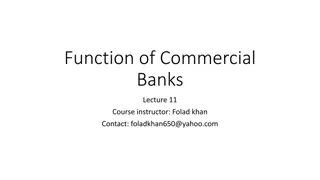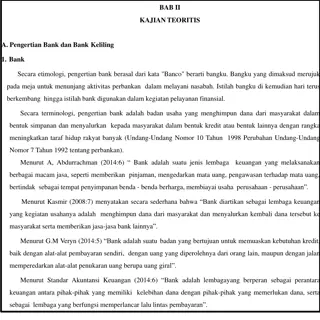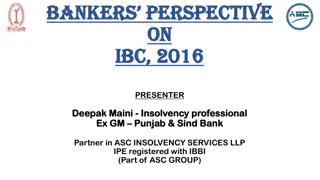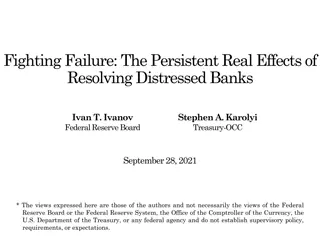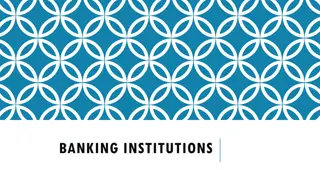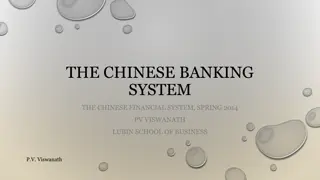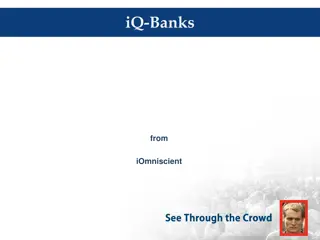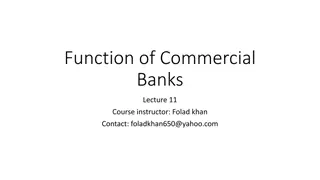Role of Banks in Economic Development
Banks play a crucial role in the economic development of a country by performing primary functions like accepting deposits and granting loans, as well as secondary functions such as agency services and general utility functions. The history of banking and the origin of the term "bank" reflect the importance of finance in trade and commerce. Understanding the functions of banks helps in comprehending their significance in the financial system.
Download Presentation

Please find below an Image/Link to download the presentation.
The content on the website is provided AS IS for your information and personal use only. It may not be sold, licensed, or shared on other websites without obtaining consent from the author.If you encounter any issues during the download, it is possible that the publisher has removed the file from their server.
You are allowed to download the files provided on this website for personal or commercial use, subject to the condition that they are used lawfully. All files are the property of their respective owners.
The content on the website is provided AS IS for your information and personal use only. It may not be sold, licensed, or shared on other websites without obtaining consent from the author.
E N D
Presentation Transcript
COMMERCIAL BANK A Commercial bank is a financial institution that deals with deposits, advances, and other related services. It receives money from those who want to save in deposits and lends money to those who need it. From the above definitions, a bank means a financial institution that; Deals with money; it accepts deposits and advances loans. It also deals with credit; it has the ability to create credit, i.e., the ability to expand its liabilities as a multiple of its reserves. It is a commercial institution; it aims at earning profit. It is a unique financial institution that creates demand deposits that serve as a medium of exchange, and as a result, the banks manage the country s payment system. Finally, we can say that bank is an organization where people and businesses can invest or borrow money, change it to foreign money, etc. or a building where these services are offered.
WHERE THE WORD BANK CAME FROM The history of the banking industry is long and vast, and Finance is the lifeblood of trade, commerce, and industry. The development of any country mainly depends upon the banking system. The term bank is either derived from the old Italian word Banca or the French word Banque, both mean a Bench or money exchange table. In the olden days, European money lenders or money changers displayed (show) coins of different countries in big heaps (quantity) on benches or tables for lending or exchanging. Nowadays, the banking sector acts as the backbone of modem business.
FUNCTIONS OF BANKS 1.Primary Functions of Banks. 1.Accepting Deposits. 1.Saving Deposits. 2.Fixed Deposits. 3.Current Deposits. 4.Recurring Deposits.
FUNCTIONS OF BANKS 2. Granting of Loans and Advances. 1.Overdraft 2.Cash Credits 3.Loans 4.Discounting of Bill of Exchange
FUNCTIONS OF BANKS 2. Secondary Functions of Banks. 1.Agency Functions. 1.Transfer of Funds. 2.Collection of checks. 3.Periodic Payments. 4.Portfolio Management. 5.Periodic Collections. 6.Other Agency Functions.
FUNCTIONS OF BANKS 2. General Utility Functions. 1.Issue of Drafts, Letters of Credit, etc. 2.Locker Facility. 3.Underwriting of Shares. 4.Dealing in Foreign Exchange. 5.Project Reports. 6.Social Welfare Programs. 7.Other Utility Functions.
A. PRIMARY FUNCTIONS OF BANKS The primary functions of a bank are also known as banking functions. They are the main functions of a bank. These primary functions of banks are explained below. 1. Accepting Deposits The bank collects deposits from the public. These deposits can be of different types, such as 1.Saving Deposits: This type of deposit encourages saving habits among the public. The rate of interest is low. At present, it is about 4% p.a. 2.Fixed Deposits: The lump sum amount is deposited at one time for a specific period. A higher rate of interest is paid. 3.Current Deposits: This type of account is operated by businessmen. Withdrawals are freely allowed. No interest is paid. 4.Recurring Deposits: This type of account is operated by salaried persons and petty traders. Withdrawals are permitted only after the expiry of a certain period. A higher rate of interest is paid.
A. PRIMARY FUNCTIONS OF BANKS 2. Granting of Loans and Advances The bank advances loans to the business community and other members of the public. The rate charged is higher than what it pays on deposits. The types of bank loans and advances are: 1.Overdraft: This type of advance is given to current account holders. It is sanctioned to business people and firms. An overdraft facility is granted against collateral security. 2.Cash Credits: The client is allowed cash credit up to a specific limit fixed in advance. The cash credit is given against the security of tangible assets and or guarantees. The advance is given for a longer period, and a larger loan amount is sanctioned than that of an overdraft. 3.Loans: It is normal for the short term, say a period of one year, or medium-term, says a period of five years. Nowadays, banks do lend money for the long term. Loans are normally secured against the tangible assets of the company. 4.Discounting of the bill of exchange: The bank can advance money by discounting or purchasing bills of exchange, both domestic and foreign. The bill is presented to the drawee or acceptor of the bill on maturity, and the amount is collected.
B. SECONDARY FUNCTIONS OF BANKS The bank performs some secondary functions, also called non-banking functions. These important secondary functions of banks are explained below. 1. Agency Functions The bank acts as an agent of its customers. The bank performs several agency functions, which include:- 1.Transfer of Funds: The bank transfers funds from one branch or place to another. 2.Collection of checks: The bank collects the checks money through its customers clearing section. The bank also collects money from the bills of exchange. 3.Periodic Payments: On standing instructions of the client, the bank makes periodic payments regarding electricity bills, rent, etc. 4.Portfolio Management: The banks also undertake to purchase and sell the shares and debentures on behalf of the clients and accordingly debit or credit the account. This facility is called portfolio management. 5.Periodic Collections: The bank collects salary, pension, dividend, and other periodic collections on behalf of the client. 6.Other Agency Functions: They act as trustees, executors, advisers, and administrators on behalf of their clients. They act as representatives of clients to deal with other banks and institutions.
B. SECONDARY FUNCTIONS OF BANKS 2. General Utility Functions The bank also performs general utility functions, such as, 1.Issue of Drafts and Letter of Credits: Banks issue drafts for transferring money from one place to another. It also issues letters of credit, especially in the case of import trade. It also issues travelers checks. 2.Locker Facility: The bank provides a locker facility to safely store valuable documents, gold ornaments, and other valuables. 3.Underwriting of Shares: The bank underwrites shares and debentures through its merchant banking division. 4.Dealing in Foreign Exchange: Commercial banks are allowed by.RBI to deal in foreign exchange. 5.Project Reports: The bank may also undertake to prepare project reports on behalf of its clients. 6.Social Welfare Programs: It undertakes social welfare programs, such as adult literacy programs, public welfare campaigns, etc. 7.Other Utility Functions: It acts as a referee to customers financial standing. It collects creditworthiness information about clients of its customers. It provides market information to its customers, etc. It provides travelers check facilities.
